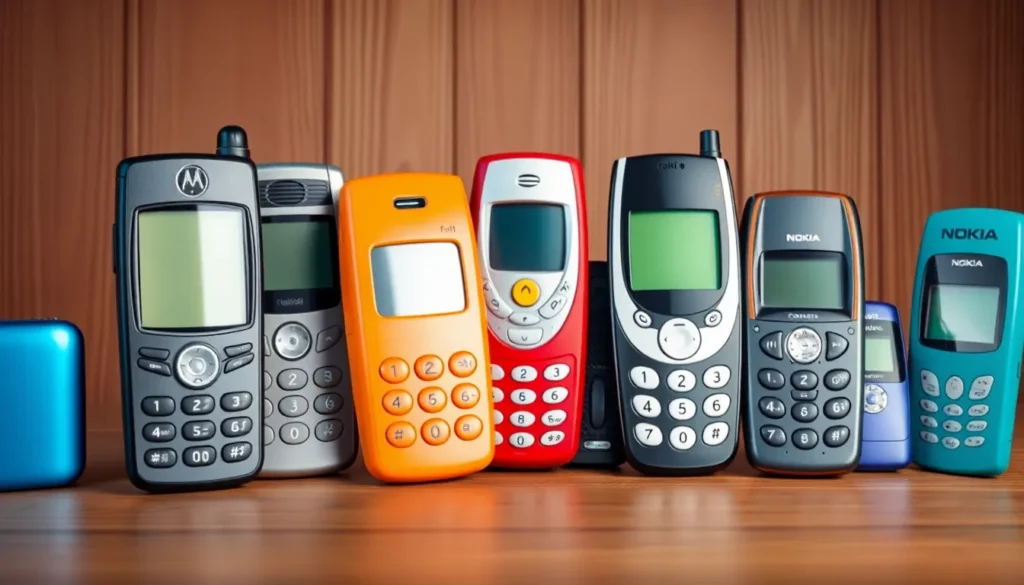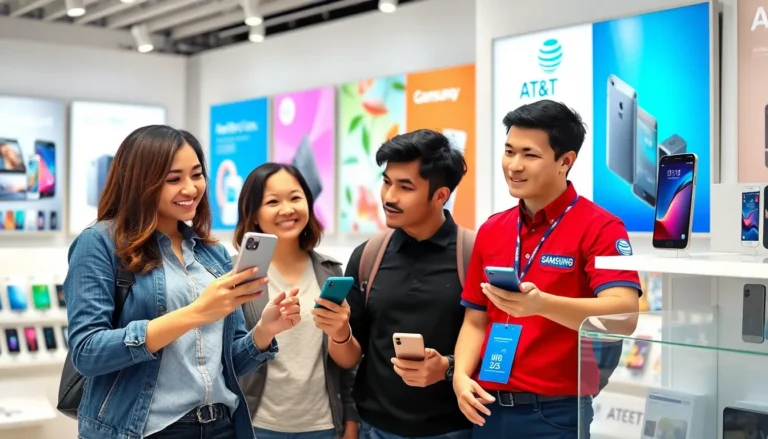Table of Contents
ToggleRemember when phones were more than just sleek rectangles? The 2000s brought a wave of quirky designs and unforgettable features that defined a generation. From flip phones that snapped shut with a satisfying click to candy bar models that made texting feel like an Olympic sport, these devices were as much about personality as they were about functionality.
Iconic Designs of Popular 2000s Phones
The 2000s era brought forth unique and memorable mobile phone designs. Distinct features and creativity defined this decade in technology.
Nokia’s Influence on Mobile Design
Nokia’s phones became synonymous with durability and functionality. The Nokia 3310, released in 2000, featured a simple candy bar design that’s still loved today. Its robust nature allowed it to survive drops and other rough handling, making it a favorite for many users. Multiple color options and customizable ringtones added a personal touch, especially popular among younger audiences. Nokia’s focus on usability also led to intuitive interfaces that set the standard for future devices.
The Flip Phone Craze
Flip phones revolutionized the way people interacted with technology. Models like the Motorola Razr debuted in 2004 and quickly captured attention with their sleek design and vibrant colors. The compact size appealed to users who valued portability. Stylish and functional, these devices often came with unique features like external displays for easy access to notifications. Additionally, the satisfying snap when closing a flip phone created a tangible sense of satisfaction, marking an iconic era in mobile history.
Popular 2000s Phones That Changed The Game

Mobile phones from the 2000s left a lasting impact on technology and culture. Some models became icons, influencing styles and user experiences.
Motorola Razr: A Cultural Phenomenon
The Motorola Razr redefined mobile design and user experience. Launched in 2004, its sleek, foldable design appealed to young users. Users admired its thin profile, which fit comfortably in pockets. The satisfying snap of opening and closing added a tactile element. As a result, celebrities and trendsetters embraced the Razr, making it a must-have accessory. Motorola sold over 130 million units by 2011, solidifying its status as a cultural icon. Ultimately, its influence spurred advancements in design, paving the way for future smartphones.
Blackberry: The Businessman’s Choice
Blackberry catered to professionals seeking efficiency and communication. Launched in 1999, it gained popularity in the 2000s for its email capabilities. Users valued the physical keyboard, which enabled fast message typing. The device’s secure email service attracted businesses, enhancing productivity. By 2011, Blackberry had around 43 percent of the smartphone market share. As a result, it became synonymous with corporate communication. Blackberry’s innovation in mobile data security set a benchmark for competitors, prompting widespread adoption in industries.
Technological Advancements in the 2000s
The 2000s marked a pivotal era in mobile phone technology, introducing innovations that transformed user experiences.
Introduction of Touchscreens
Touchscreen technology emerged during this decade, revolutionizing how users interacted with their devices. Apple’s iPhone debuted in 2007, showcasing a capacitive touchscreen that eliminated the need for physical buttons. This sleek design invited users to engage with apps and features through direct touch, fostering a new wave of mobile interaction. Other manufacturers soon adopted similar technology, spurring competition in usability and design. Consequently, touchscreen functionality became a standard across the industry, paving the way for smartphones as we know them today.
Rise of Mobile Apps
The development of mobile apps took center stage in the 2000s, significantly enhancing phone capabilities. Apple launched the App Store in 2008, providing a platform for third-party developers to create applications. Users enjoyed access to a diverse array of apps, from games to productivity tools, which expanded phone utility beyond mere communication. This shift encouraged innovation within various industries, creating new revenue streams and changing consumer behavior. By 2011, more than 500,000 applications were available, marking the mobile app economy’s rapid growth and potential.
Cultural Impact and Legacy of 2000s Phones
Mobile phones from the 2000s left a lasting mark on culture and technology. Not only were these devices practical, they also impacted social interactions and trends.
2000s Phones in Pop Culture
Devices like the Motorola Razr became cultural icons, featured prominently in movies and music videos. Celebrities embraced them, making the Razr a status symbol among youth. Moreover, various TV shows highlighted these phones, showcasing their unique designs and capabilities. The nostalgia surrounding these models remains strong, as people fondly recall the flip and slide features that defined a generation. Beyond individual users, the phones’ role in pop culture influenced fashion trends, making vibrant accessories essential for personal expression.
Nostalgia for Vintage Mobile Devices
Many people feel a sense of nostalgia for vintage mobile devices, recalling their first experiences with these classic models. Collectors appreciate models like the Nokia 3310 for their simplicity and durability. Emotional connections often arise from memories of teenage years tied to phone usage, marking significant moments in life. Social media platforms frequently celebrate these devices through memes and retrospectives, reinforcing their legacy. As a result, the charm of early 2000s phones continues to resonate, highlighting their place in both personal and collective histories.
The 2000s marked a pivotal era in mobile phone history that shaped both technology and culture. With their distinctive designs and innovative features these devices created a sense of identity for users. The nostalgia surrounding models like the Nokia 3310 and Motorola Razr highlights their lasting impact on society.
As technology continues to evolve the influence of these iconic phones remains evident. They not only paved the way for modern smartphones but also set trends that resonate today. The charm and character of 2000s phones continue to captivate collectors and enthusiasts alike ensuring their legacy endures in the hearts of many.





